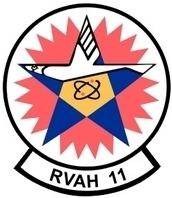Country United States Role Photo-reconnaissance Nickname(s) Checkertails | Part of Inactive | |
 | ||
Active 3 December 1951-1 June 1975 | ||
RVAH-11 was a Reconnaissance Attack (Heavy) Squadron of the U.S. Navy. Originally established as Composite Squadron Eight (VC-8) on 3 December 1951, it was redesignated Heavy Attack Squadron Eleven (VAH-11) on 1 November 1955 and was redesignated as Reconnaissance Attack (Heavy) Squadron Eleven (RVAH-11) on 1 July 1966. The squadron was disestablished on 1 June 1975.
Contents
VC-8
VC-8 was established on 3 December 1951 at NAS Patuxent River, Maryland. A small group of officers collected from various other squadrons of the Heavy Attack Wing at NAS Patuxent River assembled in the Fleet Aircraft Support Squadron 52 Ready Room to hear Commander Eugene P. Rankin, one of the pilots of the famed P2V-1, the "Truculent Turtle," read the orders establishing VC-8. Approximately one minute after CDR Rankin finished, VC-8's first scheduled flight became airborne. Personnel from VC-5, VC-6, and VC-7 were pooled to form a nucleus for VC-8 as the first squadron equipped with the AN/ASB-1 radar bombing system that would later be incorporated into the AJ Savage and the A3D (later A-3B) Skywarrior. Unlike other VC squadrons previously formed, VC-8's first aircraft were not AJ-1 Savages, but P2V-3C Neptunes, later redesignated as P2V-3Bs. These aircraft would serve as training platforms until production AJ-1s became available for VC-8.
VC-8 later transitioned to and eventually operated both the AJ-1 and AJ-2 Savage. In 1955, VC-8 relocated to Naval Auxiliary Air Station Sanford, Florida, and on 1 November 1955, was redesignated as VAH-11.
VAH-11 / Cold War (pre-Vietnam)
VAH-11 continued to fly the AJ-1 and AJ-2 until reequipped with the A3D-2 Skywarrior in November 1957. With the replacement of the AJ-1 and AJ-2 with the new A3D, NAAS Sanford was the focus of extensive military construction during the mid and late 1950s, all intended to upgrade the installation to full naval air station status as a Master Jet Base and resulting in its redesignation as NAS Sanford. Remaining homeported at NAS Sanford throughout its existence as VAH-11, the squadron made seven Mediterranean deployments, five aboard the USS Franklin D. Roosevelt and once each aboard the USS Independence and the USS Forrestal.
Given the size and complexity of the A3D as a carrier-based aircraft, mishaps plagued the VAH community during its early years Navy-wide. VAH-11 was not immune to this, and one fifteen month period from March 1961 to June 1962 proved particularly costly:
In September 1962, the Department of Defense instituted a new aircraft designation system, discarding the legacy Navy/USMC/USCG designation system and effectively transitioning all branches of the U.S. armed forces to the USAF aircraft designation system. As a result, the A3D-2 was redesignated as the A-3B Skywarrior.
Between August 1962 and January 1965, VAH-11 was divided into two units: one with six Skywarriors performing all the normal duties of a heavy attack squadron deploying aboard Fleet aircraft carriers, and the other taking up an operational readiness posture from other heavy attack squadrons while they converted from A-3Bs to A-5As or RA-5Cs Vigilantes. In turn, VAH-11 transitioned to the RA-5C Vigilante in April 1966 and was redesignated RVAH-11 in July 1966.
Cold War/Vietnam
With the increasing U.S. military involvement in Vietnam after 1964, RVAH-11 added to the mix of RVAH squadrons participating in combat operations in Southeast Asia, although its first such deployment would be a watershed event in terms of shipboard and aviation safety for the U.S. Navy in general and Naval Aviation in particular:
Subsequent deployments were as follows:
Cold War (post-Vietnam)
With the end of the Vietnam War, RVAH-11 returned to stateside training and forward deployed operations aboard Fleet aircraft carriers. Subsequent deployments were as follows:
Attrition of airframes and the increasing maintenance and flight hour costs of the RA-5C in a constrained defense budget environment forced the Navy to incrementally retire the RA-5C and the RVAH community beginning in mid-1974. Carrier-based reconnaissance was concurrently conducted by the active duty VFP community at NAS Miramar and the Naval Reserve VFP community at Andrews AFB/NAF Washington with the RF-8G Crusader until 29 March 1987, when the last RF-8G was retired and the mission was fully transferred to the active duty and Naval Reserve VF community at NAS Miramar, NAS Oceana, NAS Dallas and NAS JRB Fort Worth as a secondary role with the F-14 Tomcat equipped with the Tactical Airborne Reconnaissance Pod System.
Following its return from its final Mediterranean deployment in 1974 and subsequent relocation to NAS Key West, RVAH-11 was disestablished at NAS Key West on 1 June 1975 following nearly 24 years of active naval service.
Home station assignments
The squadron was assigned to these home stations:
